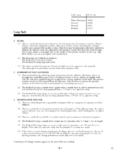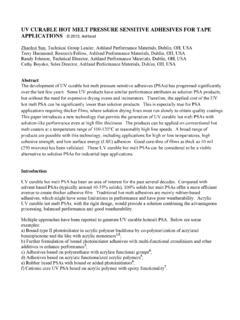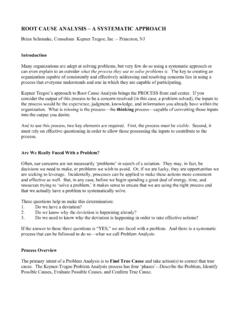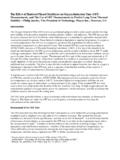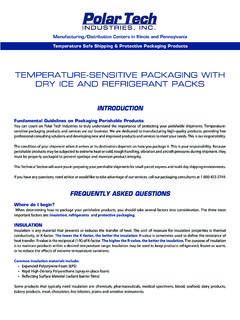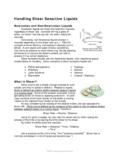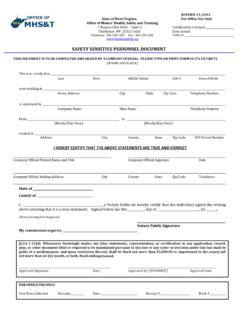Transcription of Peel Adhesion of Pressure Sensitive Tape
1 peel Adhesion of Pressure Sensitive TapeCall Letters PSTC 101 Date of Issuance 10/00 Revised 10/03 Revised 05/07101-11. These methods cover the measurement of the peel Adhesion of Pressure Sensitive tapes. peel Adhesion is the force required to remove a Pressure Sensitive tape from a test panel or its own backing at a controlled angle and at a standard rate and Test Method A gives a measure of the adherence, when peeled at 180 angle at 5 mm/sec, to a standard steel panel or other surface of interest for a single-coated Test Method B gives a measure of the adherence to the backing of a single-coated Test Method C gives a measure of adherence of double-coated tape to a standard steel panel or other surface of Test Method D gives a measure of adherence of the release liner to the adhesive of either single or double-coated Test Method E gives a measure of adherence of an adhesive transfer tape to a standard steel panel or other surface of Test Method F gives a measure of adherence, when peeled at 90 angle.
2 To a standard steel panel or other surface of interest for a single-coated These methods provide a means of assessing the uniformity of the Adhesion of a given type of Pressure Sensitive adhesive tape . The assessment may be within a roll of tape , between rolls, or between production lots. Variations in the tape backing and adhesive affect the response. Therefore, these methods cannot be used to pinpoint the specific cause(s) of These test methods may not be appropriate to test tapes having either relatively stiff backings, stiff liners, or backing showing high stretch at low forces. These characteristics will result in a high variability for the test response which is not a true indication of the real nature of the adhesive : Association des Fabricants Europeens de Rubans Auto-Adhesives (Association of European tape Manufacturers)ASTM: American Society for Testing and Materials (USA)EN: European Norm (Europe)PSTC: Pressure Sensitive tape Council (North America)Harmonized International StandardA Summary of Changes section appears at the end of this test REFERENCED ASTM Standards A 666 Specification for Austenitic Stainless Steel, Sheet, Strip, Plate and Flat Bar.
3 D 3330/D 3330M Test Method for peel Adhesion of Pressure - Sensitive tape . D 3715/D 3715M Practice for Quality Assurance of Pressure - Sensitive Tapes. D 5750 Guide for Width and Length of Pressure - Sensitive tape . Afera 5001 Self adhesive tapes - Measurement of peel Adhesion from stainless steel or from its own EN EN 1939 Self adhesive tapes - Determination of peel Adhesion SUMMARY OF TEST Test Method A - Single-coated tapes, peel Adhesion at 180 angle - A strip of tape is applied to a standard test panel (or other surface of interest) with controlled Pressure . The tape is peeled from the panel at 180 angle at a specified rate, during which time the force required to effect peel is Test Method B - Adhesion to backing, single-coated tapes - A strip of the tape under test is applied to a rigid panel.
4 A strip of the tape under test is applied to the backing of the first strip and tested for peel Adhesion as described in method Test Method C - Double-coated Face side Adhesion - A strip of double coated tape is adhered to a stainless steel panel (or other surface of interest), liner side up. The liner is removed and the exposed adhesive covered with a strip of mm thick polyester film. The resulting tape is then tested as described in method Liner side Adhesion - The face side adhesive of a strip of tape is adhered to a mm thick polyester film. The liner is removed and the strip is applied adhesive down, to a stainless steel panel (or other surface of interest).
5 Testing is conducted as described in method Test Method D - Adhesion to liner - A strip of tape is adhered to a standard steel test panel with the liner side up. The liner is peeled from the adhesive in the same manner as in peeling a strip of single coated tape from a standard panel as described in method Test Method E - Adhesion of adhesive transfer Face side - A strip of the transfer tape is adhered to a standard panel (or other surface of interest), liner side up. The liner is removed and the exposed adhesive covered with a strip of mm thick polyester film to form a film backed strip of tape . The Adhesion is measured as described in method Liner side - The face side adhesive of a strip of transfer tape is applied to a strip of mm thick polyester film.
6 The liner is removed and the strip is applied, adhesive down, to a stainless steel panel (or other surface of interest). Testing is described in method Test Method F - Single-coated tapes, 90 peel - A strip of tape is applied to a standard test panel (or other surface of interest) with controlled Pressure . The tape is peeled from the panel at a 90 angle at a specified rate, during which time the force required to effect peel is measured. 101-34. SIGNIFICANCE AND These test methods are tools for quality assurance use. Given specific Pressure Sensitive tape and a requirement in terms of the minimum or maximum peel value expected for this tape , the data from the test can be used in conjunction with acceptance Test Methods A, B, C, E, or F can show the relative bond strength of a given tape to one or more surfaces (material and texture) as compared to the standard stainless steel panel.
7 Substitution of representative samples of materials in question for the standard steel panel would suffice to do Test Methods A, B, C, E, or F cannot be used to compare two Pressure Sensitive tapes of the same type but of different manufacture for their ability to adhere to a surface. This is because the measured peel force is not normalized for a fixed area of stress. The area under stress varies with backing stiffness and adhesive rheology (firmness). Two different tapes seldom agree in these Test Method D can show the amount of force required to remove a liner that covers the adhesive side of a tape at a specified peel rate. The force will be different at other peel These test methods may not provide design information as there is usually no direct relation-ship between peel Adhesion and any functional requirement.
8 5. APPARATUS - See Appendix Specimen cutter - The specimen cutter shall hold two single-edge razor blades in parallel planes, a precise distance apart, to form a cutter of exact specimens widths. Two cutters, 12 and 24 mm cutting width, shall be available or appropriate alternates which will not cause edge - The 12 mm cutter shall consist of a 12 mm thick by 200 mm length aluminum bar stock 12 mm wide. The edges for about 125 mm from one end shall be slightly rounded to form a handle. The width of the bar for 75 mm from the opposite end shall be narrowed to exactly 12 mm minus the thickness of a single razor blade (one of two used as cutting edges).
9 The razor blades shall be held in position using side plates. The end of the cutter shall be cut away at a 45 angle to expose the cutting edge at one end of the blades. The edges shall be separated by 12 + mm. The 24 mm cutter shall follow the same description except the bar stock shall be 24 mm and shall be narrowed exactly 24 mm minus the thickness of a single razor Dispensing system, for solvents, such as a wash Panel - A 50 by 125 mm no less than mm thick stainless steel 302 or 304 in accordance with Specification ASTM A 666 having a bright annealed finish. The surface roughness height shall be 50 25 nm arithmetical average deviation from the mean line.
10 Panels showing stains, discoloration, or many scratches are not acceptable. New panels should be cleaned prior to use as described in , except with ten washes of the final solvent. Between uses, the panel test surface shall be protected from scratches and contamination, and the panels stored at conditions described in Roller, mechanically or hand operated (See Figures 1 & 2). A steel roller 85 mm in diameter and 45 mm in width, covered with rubber approximately 6 mm in thickness, having a Shore scale A durometer hardness of 80 5. The surface shall be a true cylinder void of any convex or concave deviations. The mass of the roller shall be 2040 45 No part of the apparatus shall increase the Pressure of the roller during use.

